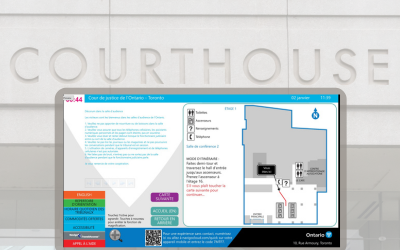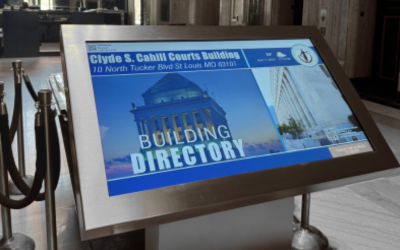|
Arrival and Orientation

As the courthouse opens, first-time visitors with limited mobility can access wheelchair-accessible interactive kiosks that welcomes them with large text, tactile buttons, and audio guidance. Visitors are greeted in English but can easily switch the interface to other language options with a tap.
The screen displays an interactive floorplan with color-coded sections and real-time updates. With a few touches, visitors find their courtroom number, learn where accessible restrooms are located, and can map a route to the nearest elevator. Thanks to voice-assisted wayfinding, they can receive step-by-step verbal instructions that guide them through the building.
Checking Docket Status

Before heading to the courtroom, visitors can access the live docket system, updated in real time. Case numbers are easy to find with searchable filters, and notifications of any updates or delay in court proceedings.
Instead of waiting nervously outside of courtrooms, visitors can relax in the seating area and access or view digital signage features such as live TV, local news updates, and a real-time weather forecast—all features designed to keep visitors informed and at ease.
Building Information and Resources

While waiting, visitors can explore additional courthouse resources via the digital signage. They can learn about on-site legal aid clinics, self-help legal forms, and where to get information about jury service. The kiosk can also highlight emergency procedures, evacuation routes, and building security contacts, ensuring all visitors can navigate with confidence and safety.
Multilingual Assistance
Visitors requiring translation service can use kiosks to access language translations of courtroom terminology and wayfinding instructions. The multilingual capabilities of the signage help bridge language gaps, empowering non-native English speakers to navigate the justice system more independently.
Transit and Traffic Updates
After the visit to the courthouse concludes, visitors can access real-time transit information displays with traffic maps, public transit schedules, and ride-share pickup zones. This information helps visitors who commute make a more informed—and less stressful—departure plan.
The Inclusive Future of Public Service

A day at the courthouse can be a success when visitors feel informed, included, and respected throughout the process. The courthouse’s use of ADA and Section 508 compliant interactive signage played a critical role in that experience—turning a potentially daunting visit into a manageable, even empowering one.
The Key Takeaway
By offering self-help tools for dockets, wayfinding, public transit, news, legal resources, and more—in multiple languages and accessible formats—the courthouse sets a new standard for public service.
This isn’t just about technology. It’s about dignity, access, and the fundamental right to understand and participate in the legal process. One digital display at a time, courthouses across the country can build smarter, more human-centered spaces for everyone who walks through their doors.
Explore itouchinc.com for more information on our solutions or contact us for needs unique to your property or project.
|


